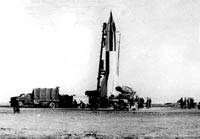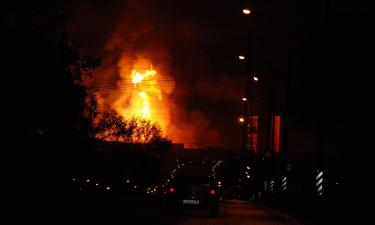Soviet Ballistic Missiles Appeared as Bulky Uncontrollable Monsters
Sixty years ago, the first Soviet ballistic missile R-1, analogue of V-2 designed by the team of Sergey Korolyov, entered the Russian Army service. The country that did not have a chance to recover from the horrible war began the era of the rocket and space equipment development. It was the time when Makhmud Rafikov was appointed cameraman at Centrnauchfilm film studio. Now, when the term of his “non-disclosure” agreement has expired, he told Izvestia about the details of his secret job.

In the beginning, missiles could not fly and generally were very uncontrollable. When they learnt how to fly, they did not always land where they were supposed to land. It often created risky situations for cameramen who had to point their lenses at them from Earth. Makhmud remembered that once an undershoot occurred and the missile that was launched 150 kilometers from the bunker exploded only a couple of kilometers from the place of the shoot. One of the crew members told the general who got out of the bunker: you are safe there behind the concrete walls, while we are risking taking the air at -20°C. In very firm words the general recommended that the crew disappeared. Makhmud told him they were sent by Korolyov. The general went back into the bunker, leaving the freezing crew members in the dark. Finally his aide emerged from the bunker and said that Korolyov stated that he could get rid of the general but not the crew. Korolyov believed that if the result was not on film, it meant it did not exist. Experiments last seconds, but the film can be watched over and over again. It was very important that cameramen were always near the testers.
Since rocket engineers had to have the image of their work from above, it was decided to conduct a shoot of the launching range from a plane. Makhmud said he colleagues were not very eager to do it. One of the crew members had a breakdown when he saw the consequences of the nuclear explosion on Earth. Rafikov agreed to shoot and filmed launching of missiles and tests of nuclear and, later, hydrogen bombs. Korolyov and Kurchatov greatly appreciated these shots because they could clearly see the results of the engineers’ work.
What were the distances between the places of explosion and the shoot location?
“It varied depending upon the power of the explosion. For nuclear blasts it was eight, five, sometimes three kilometers. The distance was higher with hydrogen blast, about 25 kilometers.”
Not everything went smoothly.
“Once, a test of an experimental nuclear warhead was scheduled near the city of Semipalatinsk. Five cameramen were getting ready for the shoot. There were 10, 9, 8 second before the explosion. On second 6 we turned the cameras on. Suddenly we heard a click, but instead of the expected powerful mushroom we saw some toadstool with a long leg and a tiny cap. So, the explosion was flawed. We turned the cameras off. Kurchatov came along with Valentin Polyakov who was responsible for all the logistics during tests. We were given another task. Since the attempt failed, and the explosion pretty much did not happen, we had to fly on a helicopter and closely approach the tower where the charge was installed and shoot a close-up of this under-exploded charge. “But you have to know that it may explode any moment,” Polyakov warned. Usually a helicopter crew has four people in it, but this time only one pilot was left not to risk too many lives. We flew right up to the tower, froze in about 50 meters away and shot the charge from four sides as directed. I wanted to take more shots closer, but the pilot was only cursing, saying he had a wife, kids, and wanted to live. So we took off. The pilot was awarded the title of the Hero of the Soviet Union. Later he came up to me in a canteen and introduced me to his commander. The commander said: “I would put you forward to a decoration, too, but I can’t since you are not a military person.”
A few days later another test was to be shot. This time Rafikov was better prepared.
“The nuclear bomb explosion was arranged at the height of approximately two kilometers. I was flying at four-five kilometers. It was low ceiling conditions. Usually it is completely dark underneath – the ground, and this time everything was white – clouds beneath, the sun shining above. And then came the blast, above the clouds. The shock wave traveled in all directions and down, and the cap of the “mushroom” turned into something unusual. It was hard to understand if it was the cap or not, there was a gigantic white circle on the bottom resembling a washbasin with the reflection of blue skies on its rim. It was a beautiful sight. But people on the ground could not see it because it was obstructed with this white circle. The scientists were specifically interested in this phase. I knew what they wanted and was shooting close-ups.”
In the beginning it seemed that everything was fine. Makhmud’s son was born, and he went to Semipalatinsk to shoot another test. There he felt something strange was happening to him. He developed unusual appetite. After a big breakfast he could barely wait until lunch at noon, and by the end of the lunch shift he was at a table again. It lasted for two weeks. In Moscow he lost his appetite for two weeks. His mother cooked his favorite meals but he could not eat even a small piece. He was running a high temperature. He was hospitalized and stayed in the hospital for a month. He lost much weight, was weak, but the doctors could not diagnose him. Makhmud was guessing he was affected by radiation but could not tell it to doctors because he signed a non-disclosure agreement.
He was transferred to a specialized clinic where he was diagnosed and treated for radiation sickness. He was offered disability benefits which he refused: “I had a young beautiful wife and a little son, I was young, I could not be considered disabled!” The film studio found a compromise, and Rafik continued working, while the studio director was instructed not to let him close to the topics of nuclear power.
Izvestia
Subscribe to Pravda.Ru Telegram channel, Facebook, RSS!



